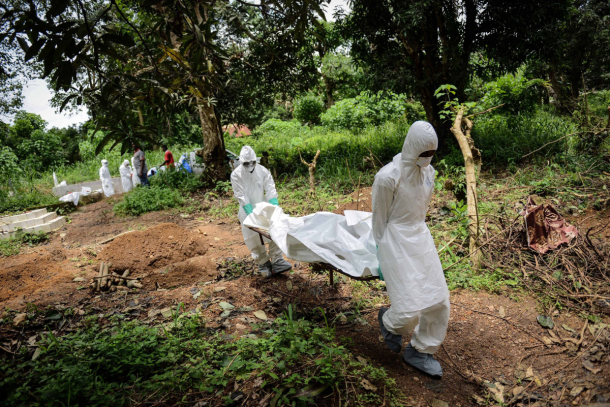Ebola epidemic far worse than being reported: running out of space in cemeteries to bury bodies

FREETOWN, Sierra Leone — The gravedigger hacked at the cemetery’s dense undergrowth, clearing space for the day’s Ebola victims. A burial team, in protective suits torn with gaping holes, arrived with fresh bodies. The backs of the battered secondhand vans carrying the dead were closed with twisted, rusting wire. Bodies were dumped in new graves, and a worker in a short-sleeve shirt carried away the stretcher, wearing only plastic bags over his hands as protection. The outlook for the day at King Tom Cemetery was busy. “We will need much more space,” said James C. O. Hamilton, the chief gravedigger, as a colleague cleared the bush with his machete. The Ebola epidemic is spreading rapidly in Sierra Leone’s densely packed capital — and it may already be far worse than the authorities acknowledge. Since the beginning of the outbreak more than six months ago, the Sierra Leone Health Ministry reported only 10 confirmed Ebola deaths here in Freetown, the capital of more than one million people, and its suburbs as of Sunday — a hopeful sign that this city, unlike the capital of neighboring Liberia, had been relatively spared the ravages of the outbreak.
But the bodies pouring in to the graveyard tell a different story. In the last eight days alone, 110 Ebola victims have been buried at King Tom Cemetery, according to the supervisor, Abdul Rahman Parker, suggesting an outbreak that is much more deadly than either the government or international health officials have announced. “I’m working with the burial team, and the first question I ask them is, ‘Are they Ebola-positive?’ said Mr. Parker, adding that the figures were based on medical certificates that he had seen himself. The deaths are carefully recorded by name and date in a notebook headed “Ebola Burials.” A burial team supervisor who drove up with fresh bodies echoed Mr. Parker’s assertion. “Anybody we collect is a positive case,” said Sorie Kessebeh. “All the bodies that we are bringing in are positive.” Beyond the many worrisome trends in the Ebola epidemic seizing parts of West Africa — the overflowing hospitals, the presence of the disease in crowded cities, the deaths of scores of health workers trying to help — another basic problem has stymied attempts to contain the disease: No one seems to know how bad the outbreak really is. The World Health Organization acknowledged weeks ago that despite its efforts to tally the thousands of cases in the region, the official statistics probably “vastly underestimate the magnitude of the outbreak.”
Here in Sierra Leone, the government just finished an aggressive national lockdown to get a handle on the epidemic, ordering the entire country to stay indoors for three days as an army of volunteers went door to door, explaining the dangers of the virus and trying to root out hidden pockets of illness. Still, the Health Ministry spokesman insisted that the epidemic was not as bad as the flow of bodies at the cemetery suggested. “It is not possible that all of them are Ebola-related deaths,” said Sidie Yahya Tunis, the Health Ministry spokesman, saying the corpses included people who died of other causes. But as the cemetery records show, the challenge facing the government might be of a different magnitude than previously thought. The majority of the recent deaths recorded at the cemetery were young people — young adults, people in early middle age, or children — with very few elderly people on the list. Several of the deaths also occurred in a concentrated area, sometimes in the same house, suggesting that a virulent infection had struck.
At the house of Marion Seisay — the third name on the list — her son acknowledged she was a secretary at Wilberforce Hospital, had died of Ebola and was buried on Sept. 14. The house was now under quarantine, with some of its eight residents lingering on the cinder-block porch. “The way my Mummy died was pathetic,” said the son, Michael Foday, clearly frustrated by the quarantine. “How do you expect us to get food?” Other houses in Wilberforce Barracks, the village-like compound surrounding the hospital, were on the list of the dead and placed under quarantine, marked off from the surrounding jumble of shacks and cinder-block houses by a thin line of red or blue string. In one of them, the house of Momoh Lomeh, the residents said that a total of five people who lived there had died of Ebola — yet four of them did not even appear on the cemetery list. At another, the house of Andrew Mansoray, a family member said that the disease had been ruthless and unrelenting. EP
